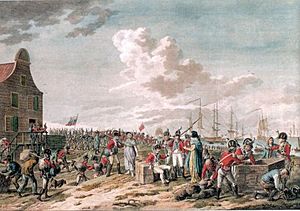56th (West Essex) Regiment of Foot facts for kids
Quick facts for kids 56th (West Essex) Regiment of Foot |
|
|---|---|
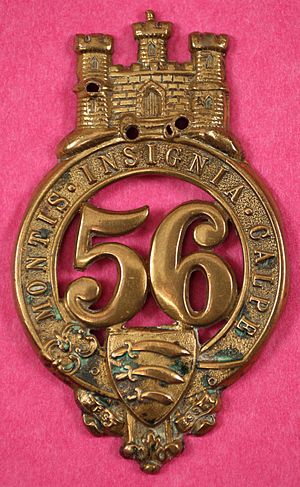
Cap badge of the 56th (West Essex) Regiment of Foot
|
|
| Active | 1755–1881 |
| Country | |
| Branch | |
| Type | Line Infantry |
| Size | One battalion (two battalions 1804–1817) |
| Garrison/HQ | Warley Barracks, Brentwood |
| Nickname(s) | The Pompadours |
| Motto(s) | Montis insignia Calpe (Badge of the Rock of Gibraltar) |
| Colors | Purple facings to uniform, silver lace |
| March | Rule, Britannia! |
| Engagements | Seven Years' War American Revolutionary War French Revolutionary Wars Napoleonic Wars Crimean War |
| Battle honours | Havannah; Moro; Gibraltar; Sevastopol |
The 56th (West Essex) Regiment of Foot was a British Army infantry (foot soldier) regiment. It was active for many years, from 1755 until 1881. This regiment was first formed in Northumbria as the 58th Regiment. The next year, it was renamed the 56th when two older regiments were closed down.
The 56th Regiment fought in many important wars. They helped capture Havana in Cuba during the Seven Years' War. Later, they defended Gibraltar during a long siege in the American Revolutionary War. They also saw action in the French Revolutionary Wars and the Napoleonic Wars. During the Napoleonic Wars, they even had a second battalion (a large group of soldiers) that fought in India and the Indian Ocean.
After these big wars, the regiment often served as guards in different countries. They also fought in the later parts of the Crimean War at the Siege of Sevastopol. They were sent to India during the Indian Mutiny but did not fight there. In 1881, the 56th Regiment joined with another regiment, the 44th (East Essex) Regiment of Foot. Together, they became the 2nd Battalion of the Essex Regiment. Today, the history of the Essex Regiment is carried on by the 1st Battalion, Royal Anglian Regiment.
History of the 56th Regiment
How the Regiment Started
In 1755, there was a lot of tension in North America. The British government decided to create ten new infantry regiments. This was to get ready for a war they expected with France, which became the Seven Years' War.
One of these new groups was the 58th Regiment of Foot. It was formed in Newcastle and Gateshead on December 28, 1755. Lord Charles Manners was its first leader. By 1756, the regiment had grown to its full size of ten companies, with 78 men in each. On December 25, 1756, two older regiments were disbanded. This meant the 58th Regiment was renumbered and became the 56th Regiment of Foot.
In 1757, the regiment moved to Berwick and then to Scotland. They served as guards in places like Aberdeen and Edinburgh. In 1760, they returned to England. In 1761, Colonel William Keppel became the new leader of the regiment.
Fighting in the West Indies
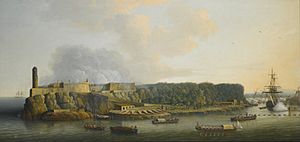
On January 4, 1762, Britain declared war on Spain during the Seven Years' War. Britain then planned to attack Spanish lands in the Caribbean. The 56th Regiment was chosen to be part of this attack. They sailed from Portsmouth on March 5 and arrived near Havana in Cuba on June 6. The next day, they landed on shore.
The regiment had 933 officers and men. Their main goal was to attack Morro Castle, which protected Havana's harbor. After a long fight, a group of soldiers stormed the castle on July 30. They captured it after a short but fierce battle. About 150 of the castle's defenders were killed. The 56th Regiment earned a special honor called "The Moro" for this brave action.
The city of Havana surrendered on August 13. The 56th Regiment lost twelve men and had 24 wounded during this campaign. The regiment stayed in Havana for a year. When Cuba was given back to Spain by the Treaty of Paris, the regiment moved to Ireland.
Defending Gibraltar
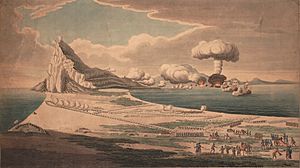
In 1770, the regiment was sent to Gibraltar. They sailed from Cork in May. In December 1770, a new light infantry company of seventy men was added to the regiment. The other companies also got more men.
The regiment stayed in Gibraltar for several years. In June 1779, Spain declared war on the United Kingdom. This started the Great Siege of Gibraltar. At that time, the 56th Regiment had about 560 men and 27 officers. This was about a tenth of all the soldiers defending Gibraltar.
Supplies were very low during the siege. In late 1781, the commander decided to try a surprise attack. This attack happened on the night of November 26. Soldiers from the 56th Regiment were part of this raiding force. They successfully destroyed several enemy artillery batteries.
The siege finally ended in February 1783. It had lasted for three years and seven months. The Treaty of Paris ended the fighting and confirmed that Britain would keep Gibraltar. The 56th Regiment received the special honor "Gibraltar" for their service. They were allowed to show a castle-and-key symbol on their flags. After the siege, they returned to England. Soon after, the regiment was given a county name to help with recruiting. It became the 56th (West Essex) Regiment of Foot.
Fighting in the French Revolutionary Wars
When the French Revolution began in 1792, the army grew larger to prepare for war. The 56th Regiment was expanded to twelve companies and got ready to serve overseas. However, before the war started, the regiment helped stop a riot near Wexford in Ireland in June 1793.
The regiment sailed to the West Indies in November 1793. They arrived in Barbados in January 1794. They fought to capture Martinique in February. Parts of the regiment also fought to capture St. Lucia in April and Guadeloupe in September. They stayed in the West Indies as guards for the rest of 1794. However, many soldiers got sick from diseases. In October, the healthy soldiers were moved to other regiments. The remaining officers and men returned to England in January 1795.
They arrived in England in February and were stationed at Chatham to get new recruits and train again. In September, they sailed to Cork, Ireland. After a short time in Ireland, they were considered ready for overseas service again. They were sent back to Barbados and then to St. Domingo, where they stayed through 1797.
In 1799, the regiment was part of a force sent to the Netherlands. This was for the Helder Campaign, which did not go well. They arrived in Holland in September and fought in the Battle of Schoorl-Oudkarspel on the 19th. They lost many men there. They also fought at Bergen and Egmont-op-Zee on October 2. They left the Netherlands on November 18.
In 1800, the regiment was in Ireland. They added two more companies of a hundred men each. New soldiers who joined after 1799 had only agreed to serve in Europe. But when they heard about the big victories in the Egyptian campaign in 1801, they offered to serve anywhere in the world. However, the Peace of Amiens came soon after in 1802, and the regiment stayed in Ireland.
The Napoleonic Wars
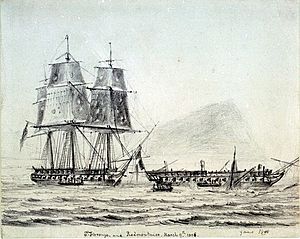
When the Napoleonic Wars began, the army grew a lot to stop any invasion. On December 25, 1804, about four hundred men from Surrey became the 2nd Battalion, 56th Regiment. This group soon grew to 656 men. The original battalion was then called the 1st Battalion, 56th Regiment. Because both battalions were good at getting new soldiers, a third battalion was created in 1813. It was called the 3rd Battalion, 56th Regiment.
Some soldiers from the regiment served as marines on ships like the Psyche and Piedmontaise in 1809–1810. They also fought in a short war against the Indian kingdom of Travancore in 1809.
1st Battalion's Adventures
The 1st Battalion moved from Ireland to the Isle of Wight in January 1805. There, it grew to a thousand men. Soon after, it sailed to Bombay (now Mumbai) in India. It stayed there as a guard for several years. In 1808, its size increased to 1300 men. A group of 200 men went to the Indian Ocean in January 1809. They successfully raided the Île Bourbon (now Réunion) in September, capturing many ships.
In August 1809, the rest of the battalion quickly sailed from Bombay to Madras (now Chennai). This was to show strength and prevent a possible mutiny (rebellion) by Indian regiments. It worked, and violence was avoided. The regiment received thanks from the Governor.
In 1810, a second trip was made to the Indian Ocean. A large group from the 1st Battalion helped capture the Île Bourbon on July 10. The same group then helped capture Mauritius in December. This was the last French land in the Indian Ocean.
New recruits joined the 1st Battalion in India in 1811. The soldiers who had been in the Indian Ocean also returned later that year. The regiment received new flags as a gift from the East India Company to honor their service in India.
When Napoleon returned to France in 1815, the battalion was sent back to Mauritius. They helped strengthen the guards there in case the French people on the island rebelled.
2nd Battalion's Journey
The 2nd Battalion moved between different places in southern England in 1805. They received their flags on November 28 at the Isle of Wight. By December, they had 866 men, which grew to a thousand in early 1806. In March 1806, they moved to Guernsey for guard duties. They returned to the Isle of Wight in early 1807 and sailed for India in June.
The battalion was split up by a storm. One group stopped at the Cape of Good Hope to fix their ships. They then continued to Madras, arriving in December. The battalion then went to Bombay, where they met the 1st Battalion for the first time. In January 1809, they moved to Surat. At Surat, four companies helped capture a bandit fort at Mallia in Baroda. They returned to the battalion in December.
The battalion grew in size in 1810, reaching 1,306 men. They suffered greatly from disease during their time in Gujarat in 1813 and 1814. They lost about 330 men. However, by January 1815, they had moved to a healthier place and had nine hundred men ready for duty.
The 2nd Battalion was ordered to be disbanded after the Battle of Waterloo. They marched to Bombay in November 1816. There, four hundred men who wanted to stay in India joined the 65th Regiment. The rest of the regiment sailed for England in January. The companies were officially disbanded in England in June and December.
3rd Battalion's Short Service
The 3rd Battalion was formed at Horsham in November 1813. It grew very quickly. Within a month, it was ready for service with 650 men. It sailed to Holland on December 9. They fought in the Battle of Merxem on January 30, 1814. After helping in the siege of Antwerp, the battalion returned to England after Napoleon gave up his power. It was disbanded on October 24. The soldiers who were still fit for service were sent to the 1st and 2nd battalions in India.
Life After the Wars
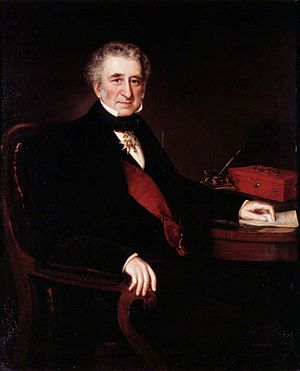
After the Napoleonic Wars, the remaining battalion of the regiment was in Mauritius. They did regular guard duties and helped stop the slave trade in the new colony. In September 1817, a big fire destroyed more than half of Port Louis, the capital city. The regiment helped fight the fire, and two men died.
In 1827, the regiment moved to Ireland. They received new flags on April 4, 1828. These flags showed the honors "Moro" and "Havannah," and the Gibraltar castle and key symbol with the motto Montis Insignia Calpe.
Under army changes in 1825, six companies would go overseas, while four stayed in the United Kingdom as a training base. So, when the regiment was sent to Jamaica in 1831, it took six of its ten companies. They had a quiet time in Jamaica, except for a brief outbreak of yellow fever in 1837, which killed sixty men.
In March 1840, the main part of the regiment sailed to Canada. They went to help guard the area during a border dispute. They returned to England in July 1842. The Earl of Westmorland became the regiment's leader on November 17, 1842.
The regiment stayed in Ireland, helping to keep peace during protests. Then they moved to England in 1844. A reserve battalion was formed that year. The main part of the regiment moved to Gibraltar in 1847. The reserve battalion joined them in February 1847 but was later disbanded. Its men joined the main force.
In May 1851, the regiment left Gibraltar for Bermuda. In September 1853, an outbreak of yellow fever spread to their barracks. More than two hundred men died. The regiment was ordered home in December 1853.
The Crimean War
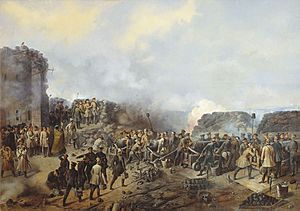
Even though the regiment was ordered home from Bermuda in 1853, they didn't sail until late 1854. During that time, the Crimean War had started. The regiment was told to get new recruits in Ireland over the winter and then sail to Turkey. In December, the first group of soldiers sailed for Constantinople.
The main part of the regiment was ordered to the Crimea in July. They landed on August 25 and moved to the front lines the next day. They were part of the forces attacking the city of Sevastopol. The regiment supported an attack on the Redan on September 8. They were not heavily involved, and only one man was wounded.
Sevastopol fell on September 11. The regiment received the battle honor "Sevastopol" for their part in the attack. Five men from the regiment were given the French Military War Medal for their brave actions.
The regiment left the Crimea on July 12, 1856. They were among the last soldiers to leave. They had served overseas for almost a year. Five men were killed in action, and thirty died from disease.
After the War and Joining Other Regiments
When the Indian Mutiny began, the regiment was in Ireland. They sailed for India in late August 1857. They stayed in Bombay during the Mutiny but did not fight in any battles.
The regiment returned from Bombay in March 1866. They arrived at Portsmouth and stayed in barracks there. After some time in England, the regiment moved to Ireland in early 1868. Then they sailed for India in February 1871. By late 1877, the regiment had moved to Aden. They were ordered home in early 1878.
In the 1870s, there were army changes called the Cardwell Reforms. Single-battalion regiments were linked together to share a training base and recruiting area. The 56th Regiment was linked with the 44th (East Essex) Regiment of Foot. They were assigned to district no. 44 at Warley Barracks near Brentwood.
On July 1, 1881, more army changes called the Childers Reforms happened. The 56th Regiment joined with the 44th (East Essex) Regiment of Foot to form the Essex Regiment. The 56th became the 2nd Battalion, the Essex Regiment.
Even though the 56th Regiment officially stopped existing, its spirit lived on. The 2nd Battalion of the Essex Regiment continued until 1948. Then, the Essex Regiment itself joined with another regiment in 1958. In 1964, this became the 3rd Battalion, the Royal Anglian Regiment. The 3rd Battalion Royal Anglians was finally disbanded in 1992. Its soldiers joined the 1st Battalion.
Regiment Traditions
The regiment's uniforms originally had a deep crimson color. In 1764, this was changed to purple. This color was often called "pompadour." This is where the regiment got its nickname, "The Pompadours." Some soldiers liked to joke that it was the color of a famous French lady's underwear!
The regiment's special march song was "Rule, Britannia!" This song remembered the regiment's past service as marines (soldiers who served on ships).
Battle Honors
The 56th Regiment proudly displayed its battle honors on its flags. These included "Moro" and "Sevastopol." They also had the Gibraltar castle and key symbol with the words "Gibraltar" and the motto Montis Insignia Calpe. The battle honor "Havannah" was also given to the 56th, but not until 1909. So, only its successor, the Essex Regiment, actually carried it.
Images for kids
-
Morro Castle before the British attack in 1762, painted by Dominic Serres
-
A view of the Grand Assault on Gibraltar by French and Spanish warships in September 1782
-
The frigate Piémontaise (on the right) was captured by the Royal Navy in 1808. Marines from the 56th Regiment served on it.
-
John Fane, 11th Earl of Westmorland, a leader of the regiment from 1842 to 1859
-
The Siege of Sevastopol in 1855, by Grigoryi Shukaev


